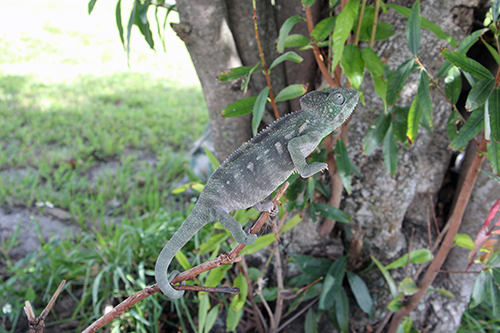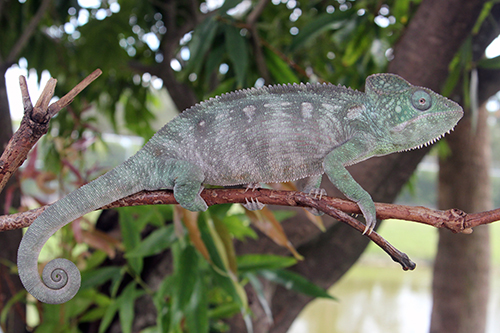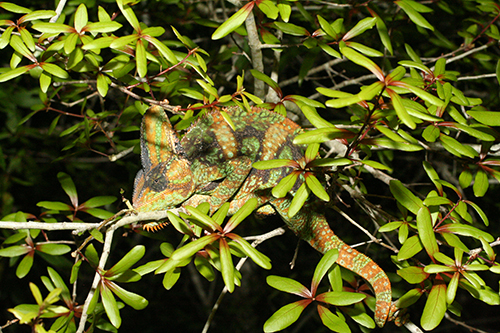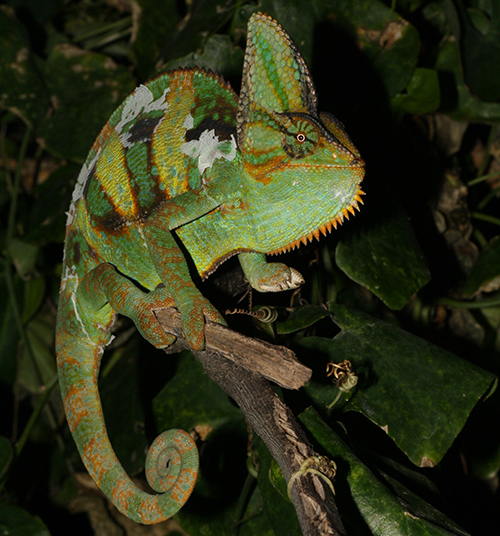Chameleons
Origin:
Old World (Africa, Madagascar, southern Europe, and southern Asia)
Introduction to Florida:
Escaped or released pets
Stage on Invasion Curve:
Eradication




Description
Chameleons are tree-dwelling lizards native to the Old World (Africa, Madagascar, southern Europe, and southern Asia). Their feet and tails are specialized to grasp tree branches, and they walk slowly, swaying like a leaf in the wind. They have large, cone-shaped eyes that rotate independently, and very long tongues that they extend rapidly to catch prey. Many species can change their skin color and pattern. Males are usually more brightly colored than females, and both sexes often have casques (helmet-like ridges) on top of their heads. Six chameleon species have been found in the wild in Florida, and two are known to be breeding.
The Oustalet’s chameleon (Furcifer oustaleti), native to Madagascar, is one of the world’s largest species. Males can grow to more than 24 incehs long and are tan with brown and black stripes. The smaller females are various shades of green with white dots along their sides. A ridge of triangular spines extends down the center of the back.
The veiled chameleon (Chamaeleo calyptratus) is native to the Arabian Peninsula. It has a large head casque and reaches lengths of 12 to 24 inches. Adult males are bright green with bold bands of yellow mixed with blue, orange, or black. Females are green with white, orange, or yellow mottling. Hatchlings are pastel green.
Impacts
Oustalet’s and veiled chameleons are predators that eat insects, small frogs and lizards, and occasionally small mammals and birds. A study of Oustalet’s chameleons in a Florida agricultural grove found that they ate mostly agricultural pests (weevils, stinkbugs, and catepillars) and nonnative reptiles and amphibians (anoles, geckos, and Cuban treefrogs). However, as chameleons become established in natural area, they may eat more native species. Velied chameleons in Hawaii have been found to threaten native birds, insects, and plants. both velied and Oustalet’s chameleons have very high reproductive rates and can tolerate a range of environmental conditions. Furthermore, people sometimes move chameleons to new locations or introduce new species into the wild. Eradication will only be possible through continuous control efforts.
Where to Find Them
Distribution Maps:
Oustalet’s chameleonVeiled chameleon
What You Can Do
- If you see a chameleon, please take a picture, note the location, and report your sighting:
- Online: IveGot1.org
- Or download the IveGot1 reporting app
- Do your research before buying an exotic pet, and remember, Don’t Let It Loose!
- Surrender unwanted exotic pets at one of FWC’s Exotic Pet Amnesty Day events or call the Pet Amnesty hotline at 1-888-IVE-GOT1
More Information
Brochures and Fact Sheets:
- The Invasion of Exotic Reptiles and Amphibians in Florida (UF)
- Pest Alert: Nonnative Lizards in Nurseries and Groves – (English)(Spanish)(Creole)
- Exotic Pet Amnesty Program: Finding Great Homes for Exotic Pets in Need (FWC)
- Buyer’s Guide to Pet Reptiles (UF)
Publications:
Websites:
- EDDMapS species information page for veiled chameleon
- FWC species information page for veiled chameleon






